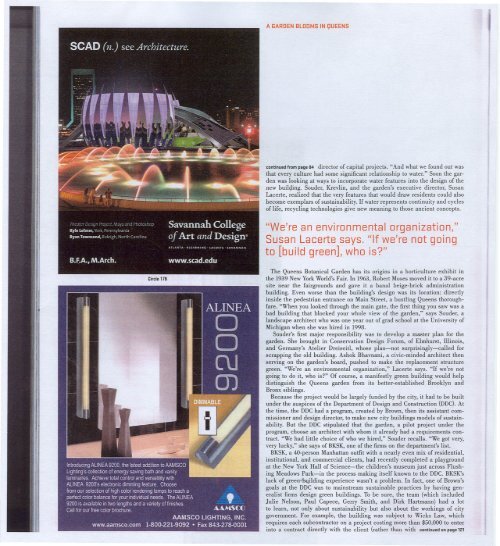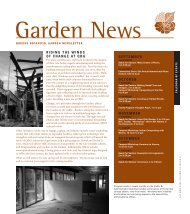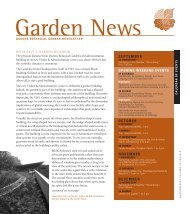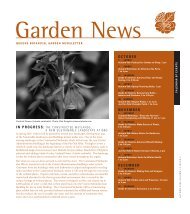Metropolis - Queens Botanical Garden
Metropolis - Queens Botanical Garden
Metropolis - Queens Botanical Garden
- No tags were found...
Create successful ePaper yourself
Turn your PDF publications into a flip-book with our unique Google optimized e-Paper software.
A GARDENBLDDMSIN QUEENS1continuedfrompage84 director of capital projects. "And what we found out wasthat every culture had some significant relationship to water." Soon the gardenwas looking at ways to incorporate water features into the design of thenew builliing. Souder, Krevlin, and the garden's executive director, SusanLacerte, realized that the very features that would draw residents could alsobecome exemplars of sustainability. If water represents continuity and cyclesof life, recycling technologies give new meaning to those ancient concepts.IIWe'rean environmental organization,"Susan Lacerte says. Hlfwe're not goingto [build green], who is?"Circle178The <strong>Queens</strong> <strong>Botanical</strong> <strong>Garden</strong> has its origins in a horticulture exhibit inthe 1939 New York World's Fair. In 1963, Robert Moses moved it to a 39-acresite near the fairgrounds and gave it a banal beige-brick administrationbuilding. Even worse than the building's design was its location: directlyinside the pedestrian entrance on Main Street, a bustling <strong>Queens</strong> thoroughfare."When you looked through the main gate, the first thing you saw was abad building that blocked your whole view of the garden," says Souder, alandscape architect who was one year out of grad school at the University ofMichigan when she was hired in 1998.Souder's first major responsibility was to develop a master plan for thegarden. She brought in Conservation Design Forum, of Elmhurst, Illinois,and Germany's Atelier Dreiseitl, whose plan-not surprisingly-called forscrapping the old building. Ashok Bhavnani, a civic-minded architect thenserving on the garden's board, pushed to make the replacement structuregreen. "We're an environmental organization," Lacerte says. "If we're notgoing to do it, who is?" Of course, a manifestly green building would helpdistinguish the <strong>Queens</strong> garden from its better-established Brooklyn andBronx siblings.Because the project would be largely funded by the city, it had to be builtunder the auspices of the Department of Design and Construction (DOC). Atthe time, the DOC had a program, created by Brown, then its assistant commissionerand design director, to make new city buildings models of sustainability.But the DOC stipulated that the garden, a pilot project under theprogram, choose an architect with whom it already had a requirements contract."We had little choice of who we hired," Souder recalls. "We got very,very lucky," she says of BKSK, one of the firms on the department's list.BKSK, a 40-person Manhattan outfit with a nearly even mix of residential,institutional, and commercial clients, had recently completed a playgroundat the New York Hall of Science-the children's museum just across FlushingMeadows Park-in the process making itself known to the DOC. BKSK'slack of green4Q.ilding experience wasn't a problem. In fact, one of Brown'sgoals at the DOC was to mainstream sustainable practices by having generalistfirms design green buildings. To be sure, the team (which includedJulie Nelson, Paul Capece, Gerry Smith, and Dirk Hartmann) had a lotto learn, not only about sustainability but also about the workings of citygovernment. For example, the building was subject to Wicks Law, whichrequires each subcontractor on a project costing more than $50.000 to enterinto a contract directly with the client (rather than with continuedonpage121








